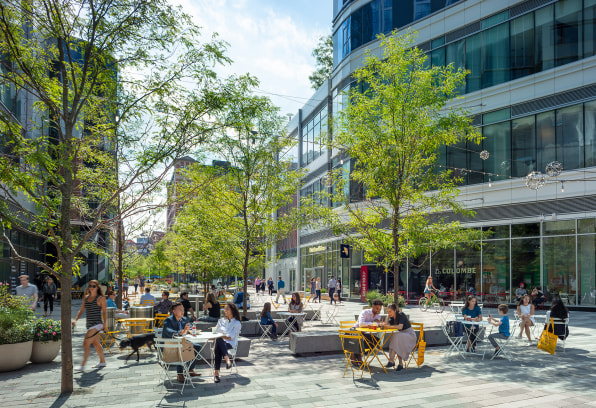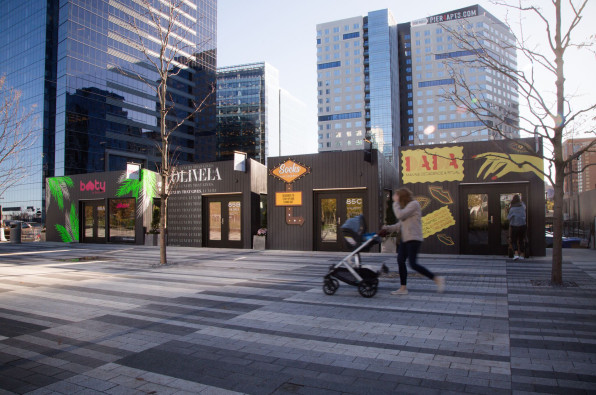All over the country, brands are offering customers a new way to shop that may just save the retail industry—and help build relationships.

I’ve been a Boston resident for nearly a decade, but I took a year-long interlude in Florida in 2017. When I returned, something strange had happened: an entirely new district, the Seaport, had sprung up, as if out of thin air.
In a way, that’s exactly what happened. The 23-acre strip of waterfront land overlooking the Boston Harbor had been mostly abandoned for decades, full of languishing warehouses and underused parking lots. In the span of a few years, Boston razed these buildings and built a new kind of neighborhood entirely from scratch, one carefully adapted for the way we live, work, and shop now. It brought in WS, a property developer, to design a mixed-use space and attract tenants.
In many ways, the Seaport represents the retail space of the future. And the strange thing about it is that it feels a lot like the kind of Main Street we see in pictures from the past, before suburban malls and shopping centers sprung up in the late 1950s and became the dominant shopping experience for half a century. Instead of setting up shop in malls, brands are increasingly entering cool neighborhoods and renting storefronts next to the places where people work, eat, and seek out entertainment. Retail in “town center”-type locations is strong; according to Public Square, occupancy rates in those areas average around 95%.

If you take a walk around the Seaport, it feels like a thriving neighborhood, where people can spend time with friends and family, and shopping isn’t the only goal. For one thing, people actually live in the many new apartment blocks in the area. You can see couples out and about in their sweatpants walking their dogs, or parents picking up groceries at Trader Joe’s with their kids in tow. But even if you live in another neighborhood, you can stop for one of the free yoga classes or group workout sessions that take place daily in the open park. There are eateries of all kinds, from one-of-a-kind restaurants to premium chains like Dig Inn and Fuku. And there are also many other fun places to visit, from the Institute of Contemporary Art to the Boston Children’s Museum to the series of colorful sculptures by the artist Okuda installed on street corners.
In some ways, the many brands that sprinkle the Seaport District are not really the point. Sure, there are shopfronts everywhere you turn, but they’re part of a broader landscape of things to do and see. And the result is that shopping feels a lot more like a communal activity you might do after a meal with friends or a visit to a museum. There are many digitally native, direct-to-consumer brands like Away, Warby Parker, Indochino, Filson, Bonobos, and Outdoor Voices in stores with small footprints. Heritage brand L.L. Bean also has a large store, complete with a dock where customers can take a canoe into the harbor. A series of shipping container-like structures called The Current is an experimental space designed exclusively for pop-ups. A single brand can either take over the entire space for a period of time, like Glossier did in the fall, or it can be reconfigured to host a variety of individual brands. Recently, Beautycounter, Le Creuset, and a quirky Boston-based winter hat company called Sh*t That I Knit were in residence.
Beyond the Museum of Ice Cream
These days, consumers no longer want to drive out to a far-away complex full of homogenous stores. In 2019 alone, more than 9,300 stores across the spectrum, from the Dollar Store to Barneys, closed locations. But as we’ve seen, consumers are still eager to spend money in physical stores, as long as the retail experiences is well-designed, entertaining, and integrated into our lifestyles. Last year, we saw many brands take the first two pillars of this concept to their rational limit with Instagrammable pop-ups, which featured striking decor that would look good in pictures. (They were all, on some level, a version of the Museum of Ice Cream.)
While the emphasis on experience remains, this trend is maturing and becoming more naturally ingrained in consumers’ lives. Going where people already are is ultimately better for brands, because it means that foot traffic is not entirely dependent on them. Their storefronts will exist in an ecosystem along with restaurants, workout studios, and cultural spots, and someone who makes a trip out to visit any one of these venues will pass by, and perhaps pop into, adjacent ones.
Across the country, there are many new retail concepts like The Current that are designed to be regularly reconfigured to feature a new group of brands. Neighborhood Goods, for instance, which launched in Plano, Texas, and just opened in the Meatpacking District in New York, brings in many brands that can adapt the space and the length of the lease to their needs. This serves the brands, which might not have the cash to invest in a large store or may be just testing out the waters in a new market. And for consumers, it’s a surprising new experience every time they come into the store.

All about community
Part of the reason that brands began building out stores in suburbs is because it was easy to find large retail spaces at affordable prices. But it turns out that many consumers aren’t that excited about driving to the edge of town to browse through an endless array of products in cavernous spaces. Many brands that typically have large stores, including Sephora and Nordstrom, are creating smaller-format stores embedded in neighborhoods. These stores feature less inventory, since customers can order items to be delivered to their homes, and store managers curate the products available on shelves to meet the needs of the specific community.
And inventory, thanks to the ease of online shopping, is almost beside the point. Buying new products just isn’t the most compelling reason for people to get off their couches and head to the store. What will draw them in is the lure of community. (There are many medical studies about how people in America feel lonely, even though they’re connected to others through social media.)
Brands can win if they create events that will bring people together in person. There are many ways to do this. In Everlane’s San Francisco store, for instance, there is stadium seating, so shoppers can lounge and chat, and so the brand can host community events. Lululemon’s stores often double as spaces for free yoga classes and running clubs. Pet brand Wild One has created dog parks at its pop-ups to bring pet lovers together. If people want to come to your store to interact with like-minded people, they’ll feel more loyal to your brand, whether or not they pick up a product during that visit.
So, in a strange way, this version of the retail store of the future will actually take us back to the past, when shopping was something we did locally, in our own communities. The large suburban malls with their harsh florescent lighting may soon be a quirky thing of the past, a weird place where people used to pass their time in the ’90s. Good riddance.
Retail - Latest - Google News
January 07, 2020 at 07:00PM
https://ift.tt/2tBOQtZ
In 2020, retail is returning to neighborhoods - Fast Company
Retail - Latest - Google News
https://ift.tt/2JDvGsM
Shoes Man Tutorial
Pos News Update
Meme Update
Korean Entertainment News
Japan News Update
No comments:
Post a Comment